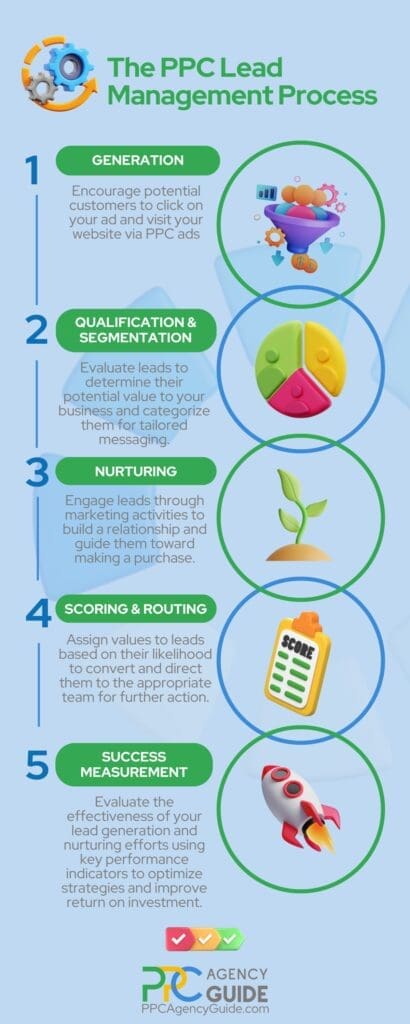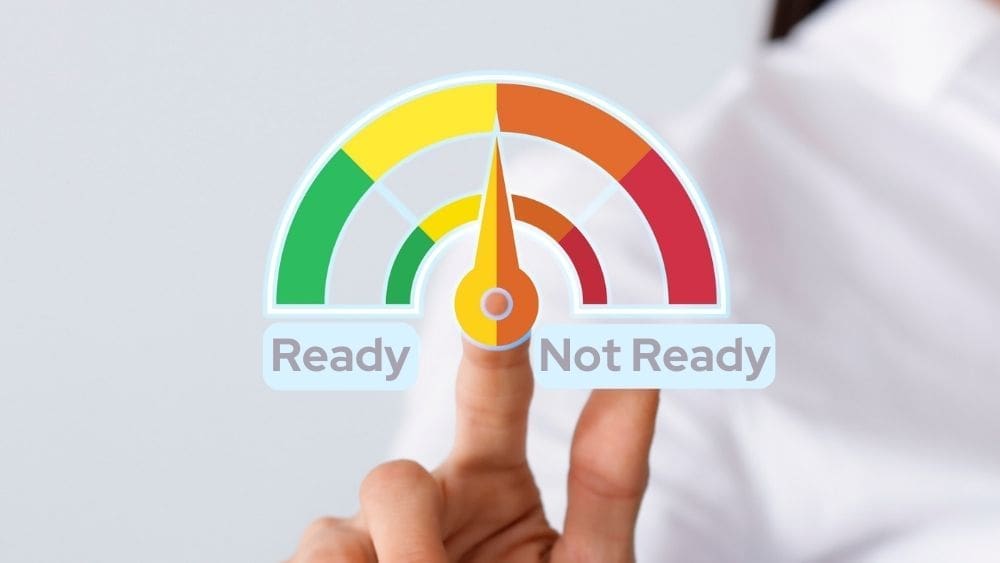
Did you know that around half of your leads are qualified but not ready to buy, per HubSpot research? Yet, only around one in five actually become customers. Effective pay-per-click (PPC) lead management closes the gap, allowing you to convert more leads in a cost-efficient way. On this page, you’ll learn how to develop a tailored PPC lead management strategy that follows best practices and fits your organization like a glove.
What is PPC Lead Management?
PPC lead management refers to the process of handling and nurturing potential customers (leads) who come to your business through PPC advertising. A typical process includes the steps outlined below.

- Lead Generation: Encouraging potential customers to click on your ad and visit your website via PPC ads.
- Lead Qualification and Segmentation: Evaluating leads to determine their potential value to your business and categorizing them based on specific criteria to tailor your engagement strategies.
- Lead Nurturing: Engaging with these leads through follow-up emails, phone calls, or other marketing activities to build a relationship and guide them toward making a purchase.
- Lead Scoring and Routing: Assigning values to leads based on their likelihood to convert and directing them to the appropriate team for further action.
- Success Measurement: Evaluating the effectiveness of your lead generation and nurturing efforts using key performance indicators (KPIs) to optimize strategies and improve ROI.
Benefits of Effective Lead Management
- Increased Efficiency: Businesses can handle leads more efficiently by automating and streamlining lead processes, reducing manual work, and minimizing errors.
- Higher Conversion Rates: Proper lead management prioritizes and nurtures high-quality leads, increasing the likelihood of conversion.
- Improved ROI: Effective lead management maximizes the return on investment (ROI) from PPC campaigns by ensuring that advertising dollars are spent on high-potential leads.
- Better Customer Insights: Lead management systems provide valuable customer behavior and preferences data, helping businesses tailor their marketing strategies.
Step 1: Lead Generation
Lead generation is the first step in PPC lead management, where the goal is to attract potential customers to your business through targeted PPC advertising. Below, we’ll briefly touch on some of the components involved.
Define Your Target Audience
- Identify Your Ideal Customer: Determine your target audience’s demographics, interests, and behaviors. This might include age, gender, location, income level, and purchasing habits.
- Create Buyer Personas: Develop detailed profiles of your ideal customers to understand their needs and motivations better. This will help you craft ads that resonate with them.
Keyword Research
- Identify Relevant Keywords: Use tools like Google Keyword Planner, Semrush, or Ahrefs to find keywords your target audience is searching for. Focus on keywords with a good balance of search volume and competition.
- Long-Tail Keywords: Incorporate long-tail keywords, which are more specific and often less competitive, to attract highly targeted leads.
Create Compelling Ads
- Ad Copy: Write clear, concise, and compelling ad copy that highlights the benefits of your product or service. Use action-oriented language to encourage clicks, such as “Get Your Free Guide” or “Shop Now.”
- Ad Formats: Based on your audience and goals, choose the appropriate ad format, such as text, display, or video. For example, display ads might work well for visually driven products, while text ads are effective for informational searches.
- Call to Action (CTA): Include a strong CTA that tells the user exactly what you want them to do, such as “Sign Up Today” or “Download Now.”
Design Effective Landing Pages
- Consistency: Ensure your landing page matches the ad’s message and design. This consistency helps reduce bounce rates and improves user experience.
- Clear Value Proposition: Communicate the value of your offering clearly. Use headlines, bullet points, and images to make your message easily digestible.
- Lead Capture Form: Include a simple, user-friendly form to capture lead information. Only ask for essential details to reduce friction, such as name and email address.
- Trust Elements: To build credibility, add trust signals like testimonials, reviews, and security badges.
Set Up Tracking and Analytics
- Conversion Tracking: Implement tracking codes, such as Google Analytics or Facebook Pixel, to monitor conversions and measure the effectiveness of your campaigns.
- Goals and Funnels: Set up goals in your analytics platform to track key actions, such as form submissions or purchases. Create funnels to understand the user journey and identify drop-off points.
Optimize and Test
- A/B Testing: Continuously test different ad copies, CTAs, and landing page designs to find the most effective combinations. A/B testing helps you understand what resonates best with your audience.
- Monitor Performance: Review campaign performance metrics (click-through rates, conversion rates, cost per conversion) regularly to identify areas for improvement.
- Adjust Bids and Budgets: Optimize your bids and budget allocation based on performance data to ensure you get the best return on investment.
Step 2: Lead Qualification and Segmentation
Lead qualification and segmentation involve evaluating and categorizing your leads based on their potential value and readiness to buy. The goal is to prioritize and tailor your engagement strategies, ensuring high-quality leads receive focused attention while others continue to be nurtured.

Collect Detailed Lead Information
- Progressive Profiling: Implement progressive profiling techniques to gather more information over time, making the initial form simple and non-intrusive while collecting deeper insights in subsequent interactions.
Define Qualification Criteria
- Demographic Information: Determine which demographic factors (age, location, job title) are most relevant to your business.
- Firmographic Information: For B2B businesses, consider company-related factors such as industry, company size, and revenue.
- Behavioral Data: Analyze the actions leads have taken on your website, such as pages visited, content downloaded, and time spent on the site.
- Explicit and Implicit Data: Combine explicit data (information provided by the lead) with implicit data (behavioral cues and engagement levels) to form a comprehensive view.
Develop a Lead Scoring System
- Assign Point Values: Create a point system to score leads based on their information and behavior. For example, a lead’s job title might be worth 10 points, while downloading a whitepaper could add another 20 points.
- Set Thresholds: Determine point thresholds that classify leads into different categories, such as sales-qualified lead, also referred to as an SQL or prospect, or sales-solidified lead, also called an opportunity.
- Automation Tools: Utilize CRM and marketing automation tools to assign scores and update lead statuses automatically. Tools like HubSpot, Marketo, or Salesforce can help streamline this process.
Segment Your Leads
- Demographic Segmentation: Group leads based on demographic criteria like age, gender, or location to tailor your marketing messages.
- Behavioral Segmentation: Segment leads by their actions, such as email engagement, website behavior, or content consumption patterns.
- Lifecycle Stage: Categorize leads by their stage in the buyer’s journey, such as awareness, consideration, or decision stages.
Personalize Lead Nurturing Campaigns
- Tailored Content: Develop personalized content and offers for each segment. For example, new leads might receive educational content, while high-scoring leads get product demos or free trials.
- Automated Workflows: Set up automated email workflows to deliver the right content at the right time based on lead segments and scores.
- Multi-Channel Engagement: Use a mix of email, social media, and direct mail to engage leads through their preferred channels.
Monitor and Adjust
- Analyze Performance: Review the performance of your lead qualification and segmentation efforts regularly. Look at metrics such as lead conversion rates and the effectiveness of personalized campaigns.
- Refine Criteria: Adjust your lead scoring criteria and segmentation strategies based on what’s working and what’s not. Continuously optimize to improve accuracy and effectiveness.
Step 3: Lead Nurturing
Lead nurturing involves building relationships with your leads through targeted communication and providing valuable content to guide them through the buyer’s journey. The goal is to keep leads engaged and move them closer to making a purchase.
Develop a Content Strategy
Identify Key Stages: Map out the buyer’s journey and identify the key stages: awareness, consideration, and decision.
Create Relevant Content: Develop content tailored to each stage. For example:
- Awareness Stage: Blog posts, educational articles, and infographics that address common pain points and introduce your brand.
- Consideration Stage: Case studies, webinars, and comparison guides that provide more in-depth information about your solutions.
- Decision Stage: Product demos, free trials, and detailed product specifications to help leads make a final decision.
Personalized Communication
- Segmented Email Campaigns: Use the lead segmentation from step two to create targeted email campaigns. Personalize emails based on lead behavior and preferences.
- Drip Campaigns: Set up automated drip email campaigns that send a series of emails over time, gradually providing more information and nudging leads toward conversion.
- Dynamic Content: Use dynamic content in emails and on your website to tailor messages based on lead segments and behaviors.
Multi-Channel Engagement
- Email Marketing: Continue to use email as a primary channel for nurturing leads. Send regular newsletters, personalized follow-ups, and targeted offers.
- Social Media: Engage with leads on social media platforms. Share relevant content, respond to comments, and participate in discussions.
- Retargeting Ads: Use retargeting ads to keep your brand in front of leads who have interacted with your website but haven’t converted yet. These ads remind them of your offerings and encourage them to return.
Interactive Content and Events
- Webinars and Live Demos: Host webinars and live demos to engage leads in real-time, answer their questions, and showcase the value of your products or services.
- Interactive Tools: Provide interactive tools like calculators, quizzes, or assessments that offer personalized insights or recommendations based on lead inputs.
Follow-Up and Check-Ins
- Personalized Follow-Ups: Have your sales team follow up with high-potential leads through personalized calls or emails. Address their specific needs and concerns.
- Regular Check-Ins: Schedule regular check-ins with leads to maintain the relationship and keep your brand top-of-mind. Use CRM tools to set reminders and track interactions.
Measure and Optimize
- Track Engagement Metrics: Monitor metrics such as email open rates, click-through rates, and content downloads to gauge the effectiveness of your nurturing efforts.
- Analyze Conversion Rates: Analyze the conversion rates of nurtured leads versus non-nurtured leads to measure the impact of your nurturing strategy.
- Optimize Campaigns: Use A/B testing and other optimization techniques to continuously improve your nurturing campaigns. Adjust content, timing, and channels based on performance data.
Step 4: Scoring and Routing
Lead scoring and routing involve evaluating each lead’s potential based on specific criteria and directing them to the appropriate team or process for further engagement. This step helps prioritize high-quality leads and ensures they receive timely and relevant follow-up.

Develop a Lead Scoring Model
Define Scoring Criteria: Determine the factors that indicate a lead’s readiness to buy. These might include:
- Demographic Information: Job title, company size, industry, etc.
- Behavioral Data: Website visits, content downloads, email engagement, social media interactions, etc.
- Firmographic Information: Company revenue, number of employees, location, etc.
Assign Point Values: Allocate points to each criterion based on importance. For example, a lead from a large company might get more points than a lead from a small company, or a lead who attended a webinar might earn more points than one who just visited your website.
Implement Scoring Mechanisms
- Automation Tools: Use CRM and marketing automation platforms to score leads automatically based on the defined criteria. Popular tools include Salesforce, HubSpot, and Zoho.
- Dynamic Scoring: Ensure your lead scoring model is dynamic, updating scores in real-time as leads interact with your content and engage with your brand.
Set Thresholds for Qualification
Define Lead Type: Establish clear thresholds that determine a lead’s type:
- Sales-Classified Lead (Lead): Someone who isn’t ready to buy yet but shows interest in your products or services.
- Sales-Qualified Lead (SQL or Prospect): Someone who shows purchase readiness and meets your qualification criterion.
- Sales-Solidified Lead (Opportunity): Someone who is ready to purchase but wants to confirm your offer meets their needs.
Lead Stages:
- Cold Leads: Low scores early in the buyer’s journey require more nurturing.
- Warm Leads: Mid-range scores showing interest might be ready for more direct engagement.
- Hot Leads: High scores, indicating strong interest and readiness to buy, should be routed to the sales team immediately.
Routing Leads to the Appropriate Team
- Sales Team: All leads should be routed to the sales team for immediate follow-up. However, hot leads (opportunities and prospects) should be prioritized. Ensure the sales team has all the necessary information to tailor their approach.
- Marketing Team: Leads that are not yet ready to buy (cold and warm leads) should be routed back to the marketing team for further nurturing.
- Automated Routing: Set up automated workflows in your CRM or marketing automation platform to ensure leads are routed to the right team based on their score.
Follow-Up Strategies
- Sales Follow-Up: For hot leads, ensure quick and personalized follow-up by the sales team. Provide context about the lead’s interactions and interests.
- Marketing Follow-Up: For warm and cold leads, continue nurturing through targeted content and engagement strategies until they are ready to be passed to sales.
Continuous Monitoring and Optimization
- Review Lead Scores Regularly: Analyze and adjust your lead scoring criteria regularly to ensure they accurately reflect lead quality and readiness to buy.
- Feedback Loop: Establish a feedback loop between sales and marketing teams. Sales should provide feedback on lead quality, helping marketing adjust their strategies and scoring models.
- Performance Metrics: Track key performance metrics such as conversion rates of leads to prospects to opportunities to customers. Use this data to refine your scoring and routing processes.
Step 5: Measure Your Success
Measuring the success of your PPC lead management efforts involves evaluating the performance of your campaigns, lead generation, nurturing, scoring, and routing processes using key performance indicators (KPIs) and other metrics. This step is crucial for understanding what’s working, identifying areas for improvement, and optimizing your strategies for better results.
Define Key Performance Indicators (KPIs)
Lead Generation Metrics:
- Click-Through Rate (CTR): The percentage of people who clicked on your PPC ad out of the total who saw it.
- Cost Per Click (CPC): The amount you pay for each click on your PPC ad.
- Conversion Rate: The percentage of visitors who completed a desired action (e.g., filling out a form) after clicking your ad.
- Cost Per Conversion: The cost associated with acquiring a lead (total cost of PPC campaign divided by the number of conversions).
Lead Quality and Engagement Metrics
- Lead Score Distribution: The range and average of lead scores to assess the quality of leads generated.
- Engagement Rates: Metrics such as email open rates, click-through rates, and content engagement to gauge lead interest and interaction.
- Lead Velocity: The speed at which leads move through the sales funnel, indicating how quickly they are progressing from one stage to the next.
Sales Performance Metrics
- Leads: The number of leads that meet the criteria to be passed to the sales team.
- Prospects: The number of leads that the sales team has vetted as ready for direct sales efforts.
- Lead-to-Customer Conversion Rate: The percentage of leads that ultimately convert into paying customers.
- Average Deal Size: The average revenue generated per converted lead.
Return on Investment (ROI)
- Total ROI: The overall return on investment from your PPC campaigns, calculated by comparing the revenue generated from converted leads to the total cost of your PPC efforts.
- Customer Lifetime Value (CLV): The projected revenue a single customer will generate over the course of their relationship with your business, helping to assess the long-term value of leads.
Analytics and Reporting Tools
- Google Analytics: Use Google Analytics to track website traffic, user behavior, and conversion paths. Set up goals and funnels to monitor key actions.
- CRM Reports: Leverage CRM tools like Salesforce, HubSpot, or Zoho CRM to generate reports on lead status, pipeline stages, and conversion metrics.
- Marketing Automation Analytics: Use platforms like Marketo, Pardot, or Mailchimp to track email campaign performance, lead scoring trends, and engagement metrics.
Continuous Improvement
- Regular Review Meetings: Schedule regular meetings with your marketing and sales teams to review performance data, discuss insights, and identify areas for improvement.
- A/B Testing: Continuously run A/B tests on your PPC ads, landing pages, and email campaigns to determine what works best and implement changes based on results.
- Feedback Loop: Establish a feedback loop between sales and marketing teams to ensure ongoing communication about lead quality, conversion challenges, and successful strategies.
- Adjust and Optimize: Use the insights gained from your metrics and feedback to adjust your lead generation, nurturing, scoring, and routing strategies. Optimize your PPC campaigns, ad copy, landing pages, and follow-up processes to improve overall performance.
Put Your PPC Lead Generation on Autopilot
Once you have the right PPC lead management processes in place, things run more smoothly and efficiently, allowing you to handle – and convert – more leads than before. An experienced PPC agency can help you increase your leads with minimal effort on your part so you can focus on building your business and strengthening client relationships. To be matched with a PPC agency that understands your business and can help you grow, request a complimentary consultation.
PPC Lead Management FAQs
How do you qualify leads in PPC campaigns?
Lead qualification in PPC involves evaluating leads based on criteria like demographics, behavior, and engagement levels. Tools like CRM and marketing automation platforms score and categorize leads, prioritizing high-potential ones for follow-up while continuing to nurture others.
What are the best practices for segmenting PPC leads?
Segment leads by demographics (age, location, job title), behavior (website interactions, email engagement), and lifecycle stage (awareness, consideration, decision). Use CRM and marketing automation tools to dynamically segment leads and personalize your engagement strategies.
What tools are essential for PPC lead management?
Essential tools include CRM systems (e.g., Salesforce), marketing automation platforms (e.g., HubSpot), lead capture tools (e.g., Unbounce), analytics tools (e.g., Google Analytics), and lead scoring systems integrated within CRM and automation platforms.
How can I improve lead nurturing in my PPC campaigns?
Improve lead nurturing by creating relevant content for each buyer’s journey stage, using segmented and personalized email campaigns, and engaging through multiple channels like social media and webinars. Regularly analyze engagement metrics to refine your strategy.
What metrics should I track to measure PPC lead management success?
Track metrics like click-through rate (CTR), conversion rate, cost per conversion, lead score distribution, lead-to-customer conversion rate, average deal size, and overall return on investment (ROI) to gauge PPC lead management success.
How do I create effective landing pages for PPC lead generation?
Create effective landing pages by matching ad messaging, highlighting the value proposition, using strong CTAs, maintaining a clean design, including trust elements, and featuring simple forms to reduce friction and capture essential information.
What is the role of CRM in managing PPC leads?
A CRM system stores and organizes lead information, tracks interactions, and provides insights. It automates lead scoring, segmentation, and routing, facilitating personalized follow-ups and enhancing sales and marketing efficiency for better conversions.
How can I optimize my PPC campaigns for better lead conversion rates?
Optimize PPC campaigns by conducting keyword research, creating compelling ad copy with strong CTAs, designing effective landing pages, and continuously analyzing and adjusting based on performance data to improve lead conversion rates.


















